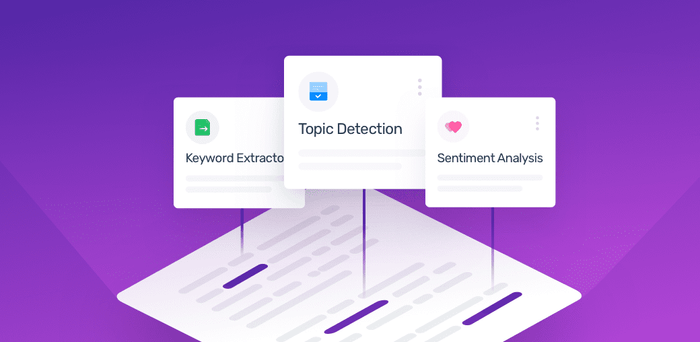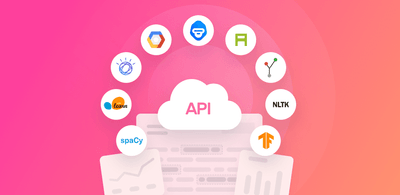Text Analysis Examples to Apply to Your Data

Instead of manually analyzing your text data, why not let AI technology automate tedious tasks?
Text analysis can help your customer support teams sort text data at scale, more accurately, and faster than human analysis. That means valuable customer insights sooner rather than later, and quicker turnarounds when it comes to making business decisions.
In this article, discover examples of text analysis, and learn about some of the many business applications of text analysis.
What Is Text Analysis?
Text analysis, also known as text mining, is a machine learning technique used to automatically extract value from text data. With the help of natural language processing (NLP), text analysis tools are able to understand, analyze, and extract insights from your unstructured data.
They make processing and analyzing huge amounts of unstructured data incredibly easy. For example, if you receive thousands of support tickets, text analysis tools can analyze them as soon as they come into your helpdesk, and alert you to any recurring issues or even angry customers that are at risk of churning.
Text Analysis Examples
There are two main text analysis techniques that you can use – text classification and text extraction. While they can be used individually, you’ll be able to get more detailed insights when you use them in unison.
Let's take a look at some examples of the most popular text analysis techniques.
- Text classification
- Sentiment analysis
- Topic analysis
- Language detection
- Intent detection
- Text extraction
- Keyword extraction
- Entity extraction
Text Classification
Text classification, also referred to as text tagging, is the practice of classifying text using pre-defined tags. There are many examples of text classification, but we’ll just touch upon some of the most popular methods used by businesses.
Sentiment Analysis
Sentiment analysis can automatically detect the emotional undertones embedded in customer reviews, survey responses, social media posts, and beyond, which helps organizations understand how their customers feel about their brand, product, or service.
Sentiment analysis of product reviews, for example, can tell you what customers like or dislike about your product. Restaurants might want to quickly detect negative reviews on public opinion sites, like Yelp. By performingsentiment analysis on Yelp reviews, they can quickly detect negative sentiments, and respond right away.
Review ites like Capterra, and G2 Crowd also offer unsolicited feedback. Take Slack, for example. Customers leave long-winded reviews that praise or criticize different aspects of the software. By running sentiment analysis, you can start organizing these reviews by sentiment in real time.
Try this sentiment analyzer, below, to see how quickly it detects sentiment:
Now, paste in your own text or use this review about Slack:
“I don’t agree with the hype, Slack failed to notify me of several important messages and that’s what a communication platform should be all about.”
By training your own sentiment analysis model to detect emotional tones in your customer feedback, you’ll be able to gain more accurate results that are tailored to your dataset.
Request a demo to see how sentiment analysis can be tailored to your use case.
Let’s go over the two main text analysis methods – text classification and text extraction – and the various models available. The one you choose will depend on the insights you are hoping to gain, and/or the problem you’re attempting to solve. Let’s take a closer look:
Text Classification
Text classification, also referred to as text tagging, is the practice of classifying text into pre-defined groups. With the help of Natural Language Processing (NLP), text classification tools are powerful enough to automatically analyze text and classify it into categories, depending on the content that you’re dealing with.
Now, let's proceed with the different types of text classification models available.
Sentiment Analysis
Nowadays, analysis falls short if it doesn’t examine the different emotions behind every piece of text. Sentiment analysis can automatically detect the emotional undertones embedded in customer reviews, survey responses, social media posts, and so on, which helps organizations understand how their customers feel about their brand, product, or service.
For example, a sentiment analysis of product reviews can help a business understand what customers like or dislike about your product. Think of review sites like Yelp, Capterra, and G2 Crowd, where you might stumble upon feedback about your, let’s say, SaaS business. In the following reviews for Slack, customers praise or criticize a few aspects of the tool:
“In love with Slack, I won’t be using anything to communicate else going forward. How did I survive without it?!” → Positive
“I don’t agree with the hype, Slack failed to notify me of several important messages and that’s what a communication platform should be all about.” → Negative
“The UX is one of the best, it's very intuitive and easy to use. However, we don't have a budget for the high price Slack asks for its paid plans.” → Neutral
By training a model to detect sentiment on the other hand, you can delegate the task of categorizing texts into Positive, Neutral and Negative, to machines. Not only does this help speed up the process, you’ll receive more consistent results since machines are inherently not biased.
Topic analysis
Topic analysis is a machine learning technique that interprets and categorizes large collections of text according to individual topics or themes.
For example, instead of humans having to read thousands of product reviews to identify the main topic that customers are talking about in regards to your product, you can use a topic analysis tool to do it in seconds.
Let’s say you’re an entertainment on-demand service company that’s just released new content, and you want to know what topics customers are mentioning. You could define tags such as UX/UI, Quality, Functionality, and Reliability, and find out which aspect is being talked about most often, and how customers are talking about each aspect. Take this review for Prime Video:
“I think Amazon is making a great effort in adding engaging content but I can’t get past the ugly interface. It’s not as intuitive as other competing streaming services and if it weren’t lumped in with my Prime membership, I wouldn’t pay for the stand-alone service.”
In this example, the topic analysis classifier can be trained to process this and automatically tag it under UX/UI.
Test MonkeyLearn’s very own feedback classifier for SaaS companies to get an idea of how topic analysis sorts information according to themes.
Language Detection
This text analysis model identifies and classifies text according to its language. This is particularly helpful for businesses with a global presence that need to route information to the correct localized teams.
Take this ticket, for example:
“La blusa es más grande de lo que esperaba, quisiera devolverla por una prenda de una talla menor.”
A language classifier could easily detect that the language is Spanish and route it to the correct customer service agent, helping businesses improve response times and avoiding unnecessary delays.
Test MonkeyLearn’s language classifier and see how it can identify over 49 different languages!
Intent Detection
Text classifiers can also be used to automatically discover customer intent in text. For example, you might receive a message like the one below:
“Sheesh, the amount of emails I receive is staggering - and it’s only been one week. It’s sporting goods, folks. I don’t need over 20 emails per week to remind me of that. Unsubscribing ASAP.”
With an intent detection classifier in place, you could quickly detect that this customer wants to ‘Unsubscribe’ and address this customer immediately. Perhaps you’ll convince them to change the settings to limit the number of emails they receive every week, rather than unsubscribe.
With a clear intent detected, you can easily classify customers and take immediate action.
Play around with the following model to classify outbound sales responses.
Text Extraction
Text extraction is a text analysis technique that extracts valuable pieces of data from text, like
keywords, names, product specifications, phone numbers, and more.
Here are some examples of text extraction models.
Keyword Extraction
Keyword extraction shows you the most relevant words or expressions in your text data. For example, if you want to understand the main topics mentioned in a set of customer reviews about a particular product or feature, you’d quickly run your data through a keyword extractor.
Entity Extraction
Entity extraction is used to obtain names of people, companies, brands, and more. This technique is particularly helpful when you’re trying to discover names of competitors in text, brand mentions, and specific customers that you want to track.
Play around with this pre-trained company extractor.
Get Started with Text Analysis
Text analysis is easy to implement with SaaS tools like MonkeyLearn and enables businesses to work more effectively. Text analysis tools take on time-consuming, tedious tasks that free human agents to focus on more important aspects of the business.
Textual analysis examples, such as sentiment analysis, topic detection, and urgency identification, help you gain a deeper understanding of your clients, so that you can improve the customer experience and listen to your customers at every step of their journey.
So, what are you waiting for? Request a demo and our team will show you how to get started with text analysis today.

Federico Pascual
September 6th, 2019







